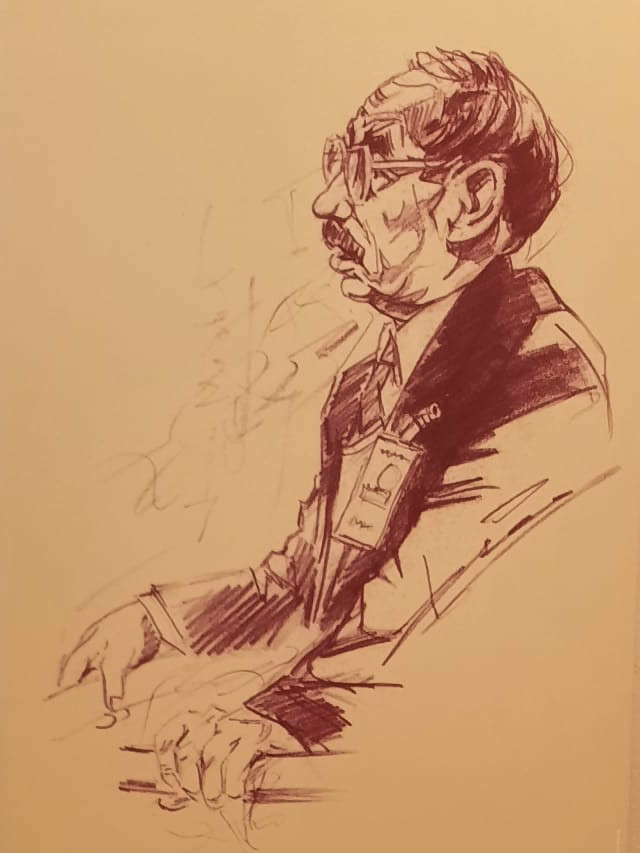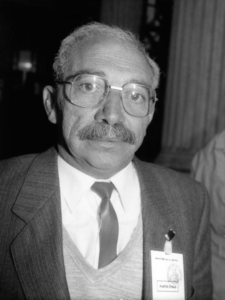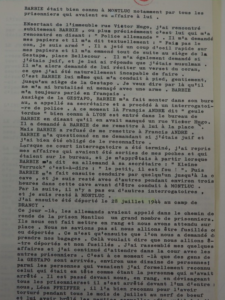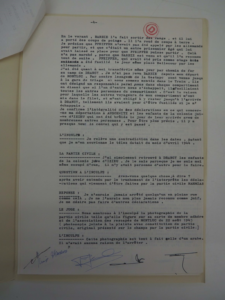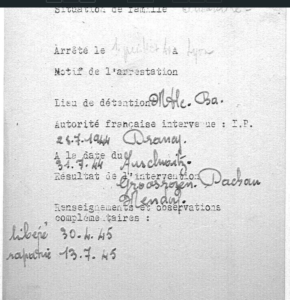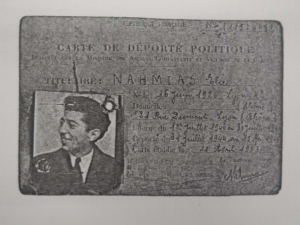Elie NAHMIAS
Introduction
This is our attempt to reconstruct the life story of Élie Nahmias, a Jewish boy who was deported during the Second World War, using the various sources that were available to us.
Élie Nahmias was born on June 16, 1926 in Lyon, in the Rhone department of France. His parents were called Israel and Ester.
In 1943, Élie Nahmias was 17 years old and was studying for a vocational training qualification while working as an apprentice boot-maker.
He was arrested in Lyon on July 1, 1944.
He later explained that he went to a building on rue Victor Hugo to drop off some mail for the Resistance. Just as he was leaving the building, he was stopped by Klaus Barbie, of the “German police”. The young Élie showed Barbie his false identity card, without the stamp to say that he was a Jew, but with his real first names: Élie and Ismaël. In his testimony, he said: “So he said to me, ‘You’re a Jew’, and I replied, ‘No, I’m a Muslim’. Then he said ‘Recite a verse from the Koran’, and of course, I couldn’t do it.” As a result, the SS officer arrested him. After a short interrogation, during which he admitted to being Jewish, he was taken to the Montluc jail in Lyon. He was then transferred to the Drancy internment camp on July 28, 1944. (source 44W13; references to sources in the Rhône departmental and Lyon metropolitan archives are listed by their file number, see detailed list below).
The photo below was taken at the Klaus Barbie trial, which took place from May 11 to July 3, 1987 and during which he appeared as a witness for the prosecution.
We therefore know that he survived after being deported to Auschwitz on July 31, 1944.
In 1968, he became a French citizen. He earned his living as a shoemaker at 21 rue Dumont in Lyon. He was Jewish.
Elie Nahmias appeared at the second Klaus Barbie trial, in 1987, during which he was one of the plaintiffs. There was a confrontation between him as a witness and the man responsible for the terrible crimes. Élie gave his testimony in court, stating: “I never took part in the resistance; I simply volunteered to help civilian victims of the American bombings at the end of May 1944.”
Below are two extracts from Élie Nahmias’s testimony at the Klaus Barbie trial.
On the left is a passage addressing his status as a Jew and explaining that he was confident that he recognized the accused.
On the right is the part in which he described his arrest in May 1944.
Sources: 44W135
The trial began on May 11, 1987. It was split into several stages, including the testimony of various witnesses who told the court about their experiences with Klaus Barbie, the reading of the indictment, the review of the charges against Barbie, the submissions of the plaintiffs etc.
The verdict was pronounced on July 4: Klaus Barbie he was sentenced to life imprisonment, which in this case means that he will remain in jail until he dies.
The arrest
Élie Nahmias was arrested on rue Victor Hugo in Lyon on July 1, 1944.
We noted that there were two different explanations for the reasons for the arrest and the circumstances in which it took place. These two versions can be found in the witness statements.
The German version of events:
Élie Nahmias was allegedly arrested as a Jewish member of the Resistance, while dropping off mail for a resistance group.
Barbie later denied the facts surrounding Élie Nahmias’s arrest, claiming that he would “never have stopped someone in the street” and that he would “never have recognized him as a Jew”.
Dialogue between the accused and the plaintiffs
In addition, Barbie declined to speak and insisted that his lawyers speak on his behalf. The plaintiffs were not happy about this, and thus also refused to answer any questions, given Barbie’s attitude.
Élie Nahmias’ version of events during the confrontation with Klaus Barbie at the second trial:
“As Élie was leaving the building, he suddenly ran into Klaus Barbie, or to be more precise, it was Barbie who approached him, with the words “German Police”. Barbie asked him for his papers and told him verbatim: “Don’t be an idiot, I’m armed!”; He took a quick look at Élie’s papers and took him straight to the Gestapo headquarters on Place Bellecour. He asked Élie if he was Jewish, and Élie replied that he was Muslim. He then asked Élie to recite a verse from the Koran, which naturally Élie could not do. It was Barbie himself who took Élie away gently, and neither bullied him nor threatened him with a weapon. Barbie always spoke to him in French.
Back at Gestapo headquarters, Barbie took Élie up to his office, called his secretary and began to interrogate him. At this point, Francis André, who was well-known in Lyon by the nickname “gueule tordue” (twisted mouth), walked into Barbie’s office and said that he had missed one on rue Victor Hugo. But Barbie refused to hand me over to Francis André. Barbie questioned Élie, asking if he was Jewish, and Élie had no choice but to admit it. When this short interrogation was over, Élie picked up his belongings, which had been removed from his pockets and were lying on the desk, and was about to leave when Barbie said in German to his secretary: “Kleine Vurruck” i.e.; “this kid, he’s crazy!” Barbie then had someone take Élie to the basement, where he stayed with some other people for about 3 minutes.”
Extract from the Élie/Barbie confrontation during the trial
These two versions of events can be better understood within the context of the trial and the charges brought against Klaus Barbie. Barbie maintained that Élie Nahmias was a political opponent and member of the Resistance, and that he was not arrested during a roundup of Jews, nor because he was Jewish.
Deportation
After he was arrested on the street on July 1, 1944, Élie Nahmias was interned in Montluc jail in Lyon.
Record from the Montluc jail archives
According to this record, Élie was detained in “Mtlc Ba”, which is short for “Montluc Barrack”. The majority of Jewish men at Montluc were held in the “Ba”, a wooden barrack hut in the courtyard that was nicknamed “La baraque aux Juifs” (“The Jewish Barrack”.)
He was in Montluc at the same time as Marcel Bloch Dassault and three members of the Emir family. While he was there, he also met Mr. Pfeiffer, who was murdered on Place Bellecour on July 27, 1944.
We have two photos of this site, taken on November 24, 1944. (Source 4544W17)
In addition, by the time he arrived in Montluc, a large number of Jews had already been arrested and the prison was overcrowded. There were almost 1,300 people imprisoned in a jail that was originally designed to hold just 127.
He stayed in Montluc until July 26, 1944.
He was then transferred to Drancy internment camp, north of Paris. In his evidence given at the trial, he stated that in Drancy, where he stayed for a few days, there were 400 children there without their parents, including those from the children’s home in Izieu.
He also noted that a number of people from Paris went to Drancy to protest and to try to have the children released from the camp.
After spending “several days” in Drancy, Élie Nahmias was deported to the Auschwitz-Birkenau camp. The children from Izieu had been deported on previous convoys and they were all murdered shortly after they arrived. Élie Nahmias was selected to work in the forced labor camp and was assigned the prisoner number B3877.
He was then transferred to the Gross-Rosen camp, and finally to Dachau, where he was assigned to a number of different kommandos (work groups).
He thus followed the same path as Lazare Lombroso, who was also deported on Convoy 77.
He was liberated on April 30, 1945 and repatriated to France on July 13, 1945.
Elie’s return to France and his state of health
Elie Nahmias was deported to Auschwitz in August 1944, transferred to Dachau and liberated by the American army on April 30, 1945.
After returning to France on July 13, 1945, he went back to live in Lyon, firstly at 21 rue Dumont and then at 61 rue Fabia.
A disability card gives some indication of his physical condition when he returned from the camps:
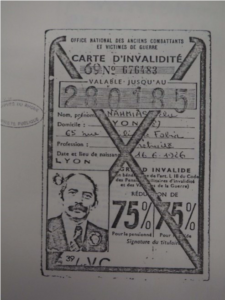
4544W30
It shows that he was deemed to be 75% disabled.
Another card demonstrates the extent to which he suffered during his internment, and how this had an impact on his physical well-being when he returned to France.:
4544W30
The title says it all: Élie Nahmias struggled to stay on his feet. The card was used to get a discount on S.N.C.F. (French National Railways) tickets.
He was also granted the status of “political deportee”, meaning that the was deported for political reasons, as this card shows:
4544W30
His life was changed forever as a result of having been deported, and he therefore decided to be one of the plaintiffs in the Klaus Barbie trial. He testified on July 19, 1983.
A witness at the Klaus Barbie trial: our key sources
In 1944, Barbie fled to the United States, where he worked for the American secret service for 3 years. The French government first applied to have him extradited in 1948, but the request was denied.
In 1951, Barbie was exfiltrated to Argentina. From there, he moved to Bolivia, where he stayed for 30 years. He became a Bolivian citizen on October 3, 1957, under the name Klaus Altmann.
In 1972, France made another extradition request, but this was refused by the Bolivian Supreme Court. The Bolivian regime sheltered Klaus Barbie. On January 25, 1983, however, Barbie was arrested and was then extradited to France on February 5. He was initially taken to Montluc, the very place where his victims had been held during the war. The following day, he was transferred to Saint-Joseph jail in Lyon.
Klaus Barbie had been sentenced to death in absentia twice, in 1952 and 1954. However, by the time he was brought back to France the death penalty had been abolished, so he had to stand trial again.
Having already been tried in 1952 and 1954, Klaus Barbie could not be prosecuted again for the same offences. He was therefore tried on three different counts:
- the UGIF (Union générales des israélites de France or General Union of French Jews) roundup on February 9, 1943,
- the roundup at the children’s home in Izieu on April 6, 1944.
- Organization of the final convoy to Auschwitz, which left Lyon on August 11, 1944.
The judge who carried out the investigation was Mr. Christian Riss.
Klaus Barbie was charged with crimes against humanity and complicity in the commission of such crimes.
The trial began on May 11 and ended on July 3, 1987. Klaus Barbie was sentenced to imprisonment for the remainder of his life.
All of the groups of students made extensive use of the minutes of the confrontation between Élie Nahmias and Klaus Barbie as a source of information. (Source 4544W13)
Élie Nahmias began by describing in detail how Barbie himself arrested him, interrogated him briefly and imprisoned him and how he was then transferred to Drancy on July 28, 1944. After that, the accused and the plaintiff engaged in a dialogue.
Élie Nahmias’ attorneys were called Berman and Hecrenroth.
Élie Nahmias was summoned to appear before the investigating judge several times, but did not do so on April 11, 1985.
During the trial, two issues were of particular importance to the plaintiffs, and Élie Nahmias was questioned extensively on both of them:
Élie Nahmias stated that he recognized Klaus Barbie as the person who arrested him on the grounds that he was Jewish.
Next, Élie Nahmias spoke about the children from the children’s home in Izieu, having been interned at the same time as them in Drancy camp, where he helped to care for them. He witnessed the children being deported.
Élie Nahmias stated that he was with the children from Izieu, and he confirmed that as soon as they arrived at Auschwitz, they were murdered and cremated.
Following the confrontation between himself and Barbie on July 19, 1983, Élie Nahmias received an abusive letter from the Embassy of the Republic of Iraq. He understood it to be a threat, and asked that an investigation be carried out to identify the author.
The envelope in which Élie Nahmias received the threatening letter
The anonymous offensive letter sent to Élie Nahmias
However, Christian Riss was unable to investigate matters that he was not already dealing with, and so he forwarded the letter to Mr. Berman, the State Attorney in Lyon.
Sources:
- Source: Victims of Contemporary Conflicts Archives Division of the French Ministry of Defense Historical Service, in Caen.
- Source: ITS (International Tracing Services) at Bad Arolsen
- Deposit certificate from the Paris Police Headquarters
Mr. Philippon, a facilitator at the National Memorial of Montluc Jail, visited the Rhône departmental archives and the Lyon metropolitan archives services and then shared the results of his research with us.
Sources from the Rhône departmental archives and the Lyon metropolitan archives:
- Source: The Montluc collection 3335W (online archives), known as “le fonds Montluc“, held in the Rhône departmental and metropolitan archives. These are records gathered or produced by the police forensic department after the war in order to trace the victims who had been held in Montluc jail.
- Source: Collection 4544W 13 (minutes of the Klaus Barbie trial)
These are the minutes of the confrontation between Élie Nahmias and Klaus Barbie. - Source: Fonds 4544W 17 (minutes of the Klaus Barbie trial)
Photographs taken by the SRIJ (Regional Forensic Identification Service) on November 24, 1944, of the so-called “Jewish barrack” at Montluc.
- Source: Fonds 4544W 30 (Klaus Barbie trial)
Links:
- https://www.memorialdelashoah.org/
- https://archives.rhone.fr/ark:/28729/fzlr8t4vkx0n/442b4697-bacc-43ae-9f1b-4d38b868613d
- https://archives.rhone.fr/ark:/28729/fzlr8t4vkx0n/3e4babde-3170-42ca-887d-0ae90e4f3eb9
- Map of Lazare Lambruso’s journey, produced by the students as part of the project: https://umap.openstreetmap.fr/fr/map/trajet-de-lazare-lombroso_730665#5/48.822/20.168


 Français
Français Polski
Polski